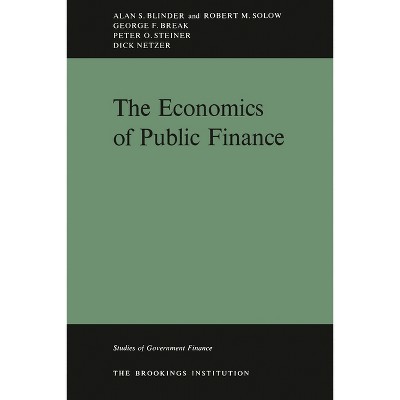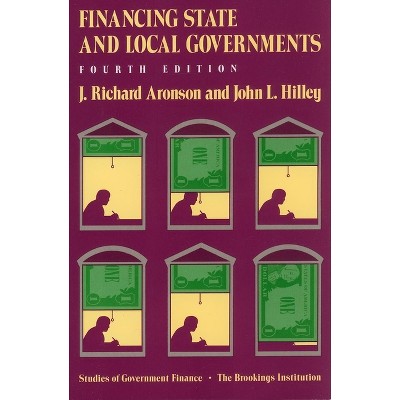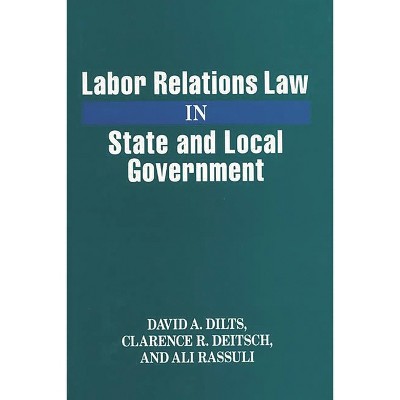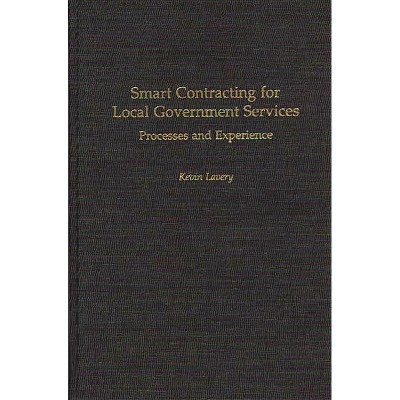Sponsored

Economics of State and Local Government - by Henry John Raimondo (Hardcover)
In Stock
Sponsored
About this item
Highlights
- While nearly everyone in the United States pays careful attention to the federal government in Washington, it is the state and local officials and bodies who are generally providing education, protecting the environment, caring for AIDS patients, financing affordable housing, and putting police and firefighters on the streets.
- About the Author: HENRY J. RAIMONDO is Associate Professor in the Eagleton Institute of Politics and the Department of Urban Planning and Policy Development at Rutgers University.
- 288 Pages
- Business + Money Management, Public Finance
Description
About the Book
While nearly everyone in the United States pays careful attention to the federal government in Washington, it is the state and local officials and bodies who are generally providing education, protecting the environment, caring for AIDS patients, financing affordable housing, and putting police and firefighters on the streets. In this text, Henry Raimondo gives these local governments some of the notice they are due, examining why state and local public finance has assumed such an important role in domestic fiscal policy matters. Traditional topics such as the theories of taxation and intergovernmental grants are combined with numerous overlooked subjects to reveal the dynamic and complex nature of state and local government fiscal behavior.
Raimondo begins his text with a look at the relationship between regional economic performance and state and local government finance, and follows with a description of U.S. economic geography. The organization of the public sector is outlined through a discussion of the political and economic dimensions of the federal system, and the guidelines for delegating services to different levels of government. Among the other topics covered are methods for financing elementary and secondary education that adjust for regional economic differences; taxation in a federal system; state and local taxes on property, sales, and personal income; user charges and gambling revenues; and the actual beneficiaries of state and local governments. The book concludes with an overview of the grants-in-aid system and its effect on spending decisions. Students of economics, urban studies, and political science will find this work to be an invaluable resource, as will professionals in public policy and planning.
Book Synopsis
While nearly everyone in the United States pays careful attention to the federal government in Washington, it is the state and local officials and bodies who are generally providing education, protecting the environment, caring for AIDS patients, financing affordable housing, and putting police and firefighters on the streets. In this text, Henry Raimondo gives these local governments some of the notice they are due, examining why state and local public finance has assumed such an important role in domestic fiscal policy matters. Traditional topics such as the theories of taxation and intergovernmental grants are combined with numerous overlooked subjects to reveal the dynamic and complex nature of state and local government fiscal behavior.
Raimondo begins his text with a look at the relationship between regional economic performance and state and local government finance, and follows with a description of U.S. economic geography. The organization of the public sector is outlined through a discussion of the political and economic dimensions of the federal system, and the guidelines for delegating services to different levels of government. Among the other topics covered are methods for financing elementary and secondary education that adjust for regional economic differences; taxation in a federal system; state and local taxes on property, sales, and personal income; user charges and gambling revenues; and the actual beneficiaries of state and local governments. The book concludes with an overview of the grants-in-aid system and its effect on spending decisions. Students of economics, urban studies, and political science will find this work to be an invaluable resource, as will professionals in public policy and planning.Review Quotes
?Raimondo's book fills a gap in the literature for both academics and practitioners. The economics of state and local government has been thoroughly explored on a piecemeal or topical basis, particularly on the finance and taxation side (e.g., Local Government Finance, ed. by John E. Peterson and Dennis R. Strachota, 1991). However, there are relatively few comprehensive studies, and only one textbook (Ronald C. Fisher's State and Local Public Finance, (1988). Thus Raimondo's work is a welcome addition, reflecting extensive experience in both government and academia. Any book in this area is somewhat idiosyncratic, and this volume is no exception. The author chooses to address the regional economies and progresses from there to private markets, the role of government, and fiscal federalism. As in most books in this area, expenditures get less attention than the revenue side, but there are two good expenditure chapters. A must for students of state and local public finance at all levels; accessible to general readers as well.?-Choice
"Raimondo's book fills a gap in the literature for both academics and practitioners. The economics of state and local government has been thoroughly explored on a piecemeal or topical basis, particularly on the finance and taxation side (e.g., Local Government Finance, ed. by John E. Peterson and Dennis R. Strachota, 1991). However, there are relatively few comprehensive studies, and only one textbook (Ronald C. Fisher's State and Local Public Finance, (1988). Thus Raimondo's work is a welcome addition, reflecting extensive experience in both government and academia. Any book in this area is somewhat idiosyncratic, and this volume is no exception. The author chooses to address the regional economies and progresses from there to private markets, the role of government, and fiscal federalism. As in most books in this area, expenditures get less attention than the revenue side, but there are two good expenditure chapters. A must for students of state and local public finance at all levels; accessible to general readers as well."-Choice
About the Author
HENRY J. RAIMONDO is Associate Professor in the Eagleton Institute of Politics and the Department of Urban Planning and Policy Development at Rutgers University. He has served on the faculty of the Department of Economics at the University of Massachusetts at Boston. Professor Raimondo has written in the areas of state-local public finance, economics of sport, and economic education. His research has appeared in Growth and Change, Journal of Economic Education, Journal of Labor Research, Land Economics, Public Budgeting and Finance, and Public Finance Quarterly.Shipping details
Return details
Trending Non-Fiction











